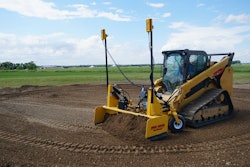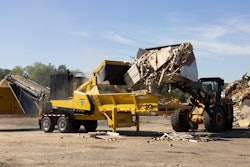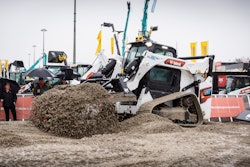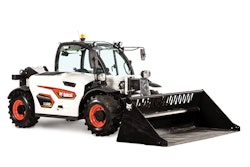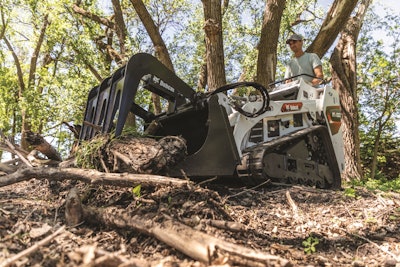
It would seem there’s not much opportunity to advance the compact utility loader, mainly because of its size.
Go too big, and you’re competing with small skid steers and compact tracks loaders, which offer greater performance at not much extra cost. And you might not be able to fit it through a standard 36-inch gate opening anymore.
Go too small and – well, you’ve gone too small. What’s the point of a 12-horsepower CUL?
Within these confines, however, OEMs have found plenty of opportunity for added features and benefits on the latest compact utility loaders – which get a variety of names from manufacturers, including mini skid steers. For this article, the term “compact utility loader” encompasses them all, be they stand-on, walk-behind, tracked or wheeled.
Here’s at look at some of the current offerings on the market and how to pick the right one:
Fitting through the gate
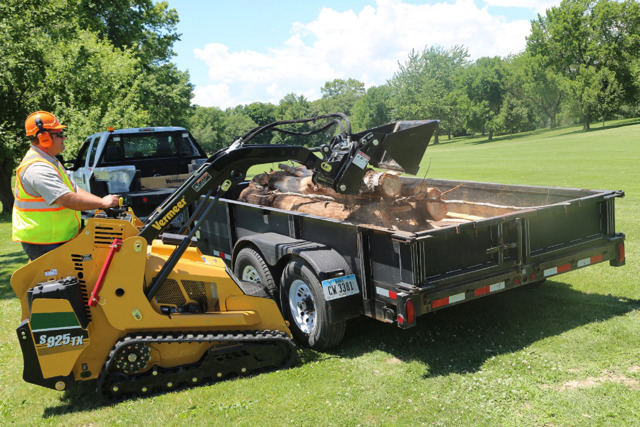 The S925TX from Vermeer has two engine options, a 24.5-horsepower Kubota V1505 diesel or a 40-horsepower Kubota WG1605 gas. ROC is 925 pounds, and operating weight is 3,465 pounds (standard bucket, diesel engine). Options include 7- or 9-inch tracks, gas or diesel engine and a universal mounting plate.VermeerVermeer has five models, ranging from the 24.8-horsepower S450TX to the 40-horsepower CTX160. All are stand-on, and all are diesel except that the S925TX is also available with a gas engine.
The S925TX from Vermeer has two engine options, a 24.5-horsepower Kubota V1505 diesel or a 40-horsepower Kubota WG1605 gas. ROC is 925 pounds, and operating weight is 3,465 pounds (standard bucket, diesel engine). Options include 7- or 9-inch tracks, gas or diesel engine and a universal mounting plate.VermeerVermeer has five models, ranging from the 24.8-horsepower S450TX to the 40-horsepower CTX160. All are stand-on, and all are diesel except that the S925TX is also available with a gas engine.
All but the CTX160 have standard 7-inch tracks, with 9-inch tracks as options; the CTX160 comes standard with 9-inch tracks. Tracks to reduce turf disturbance with smaller lugs are also available.
The four smaller models will fit through a 36-inch gate when equipped with 7-inch tracks.
The CTX160 is 42 inches wide, which is narrow for a machine with a 1,600-pound rated operating capacity. It is 116 inches long with the standard bucket.
“Vermeer designed the CTX160 to be longer, rather than wider, to create the required footprint for a loader of this capacity,” says Kyle Newendorp, product specialist. “The result is a stable machine that still fits through a 42-inch gate.”
Gaining popularity with contractors
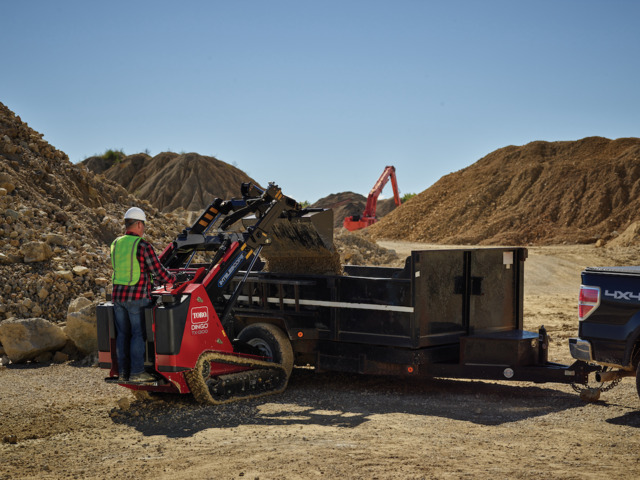 The Intelescope loader arm on the Toro Dingo TX 1300 delivers a hinge pin height of 109 inches. Power comes from a 37-horsepower Yanmar diesel engine. ROC is 1,300 pounds, operating weight is 3,858 pounds, and width is 46 inches. Hydraulic pressure is 3,200 psi. Drive controls are at the left hand, while telescoping and auxiliary functions are on the right for easier pick, place and load.ToroSome brands are strongly associated with specific types of equipment. Toro’s Dingo CULs, for instance, enjoy that status, even as they grow in size and performance.
The Intelescope loader arm on the Toro Dingo TX 1300 delivers a hinge pin height of 109 inches. Power comes from a 37-horsepower Yanmar diesel engine. ROC is 1,300 pounds, operating weight is 3,858 pounds, and width is 46 inches. Hydraulic pressure is 3,200 psi. Drive controls are at the left hand, while telescoping and auxiliary functions are on the right for easier pick, place and load.ToroSome brands are strongly associated with specific types of equipment. Toro’s Dingo CULs, for instance, enjoy that status, even as they grow in size and performance.
“Until about 10 years ago, CULs were still considered tools for weekend warriors and DIYers,” says Kyle Cartwright, Toro marketing manager. “They lacked the power that most contractors demand.”
Now, he says, higher operating capacities, technological advances and improved overall performance have made CULs popular with contractors.
Toro’s TXL 2000 Telescoping model delivers 123.4 inches of hinge pin height with the arms extended and has an overall width of 54 inches.
The new Dingo TX 1300 brings many of the advantages of the TXL 2000 to a slightly smaller machine. It uses the Intelescope telescoping loader arms for a 109.2-inch hinge pin height and 26.7 inches of reach, fully raised. It has a 1,300-pound operating capacity and 37 horsepower compared to the TXL 2000’s 2,000-pound capacity and 46.9-horsepower, but it also brings overall width down to 46 inches.
Beyond buckets and forks
Compact utility loaders have always emphasized the “utility” portion of their name, but historically that was with buckets and forks. The market is now rich with attachments that make the most of loaders’ roles as providers of portable hydraulic power.
“Bobcat mini track loaders deliver impressive performance with a wide selection of attachments,” says Katie Redenius, product manager, Doosan Bobcat North America. That list includes not just buckets and forks but augers, trenchers, stump grinders, sweepers, snow blades, the Brushcat rotary cutter, a boring unit, a landplane, a rotary tiller and a log grapple.
The log grapple, launched in 2021, has a free-hanging design with a 56-inch grapple opening, an integrated tree pusher and heavy-duty teeth to help stabilize logs during operation. The grapple is popular in the forestry segment and for landscapers, which make up 70% of the market, according to data Redenius provided.
Even legacy products are morphing into new forms, such as the new high-dump bucket available from Vermeer. The hydraulically assisted bucket provides greater dump height and faster cycle times, says Newendorp.
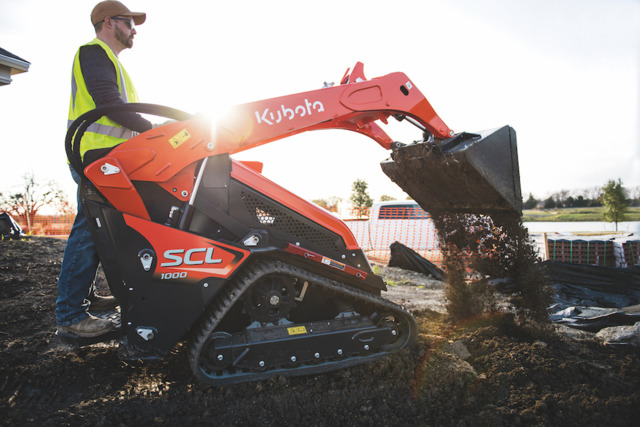 The Kubota SCL1000 is powered by a turbocharged Kubota diesel engine rated at 24.8 horsepower. Even with standard 9.8-inch tracks, overall machine width is just 36 inches. Hydraulic flow is 15 gpm and pressure is 2,800 psi; the hydraulic pump mounts directly to the engine for reduced maintenance.KubotaManaging such an array of attachments is its own challenge.
The Kubota SCL1000 is powered by a turbocharged Kubota diesel engine rated at 24.8 horsepower. Even with standard 9.8-inch tracks, overall machine width is just 36 inches. Hydraulic flow is 15 gpm and pressure is 2,800 psi; the hydraulic pump mounts directly to the engine for reduced maintenance.KubotaManaging such an array of attachments is its own challenge.
Kubota’s answer on the SCL1000 is a patent-pending T-handle drive for intuitive steering, pilot control valves for loader and drive functions, control of auxiliary hydraulics while the operator’s hand remains on the joystick, and a 4.3-inch color LCD monitor.
Other features on the SCL1000 include keyless start with passcode protection, cushioned loader boom cylinders, and adjustable platform suspension for operator comfort.
Growing applications
Brant Kukuk, compact equipment product manager, Ditch Witch, says fiber-optics installation is driving equipment development as providers seek to bring services directly to customers.
“These sites are often tight, congested and heavily trafficked. Demand is for fast turn-around. Because of this, utility contractors are turning to stand-on skid steers for fiber installation projects.”
Applications associated with fiber installation include microtrenching, coring and simple concrete removal, says Kukuk. Ditch Witch has released several microtrenching attachments in recent years. The latest is the MT164, which will create trenches up to 2 inches wide and 16 inches deep.
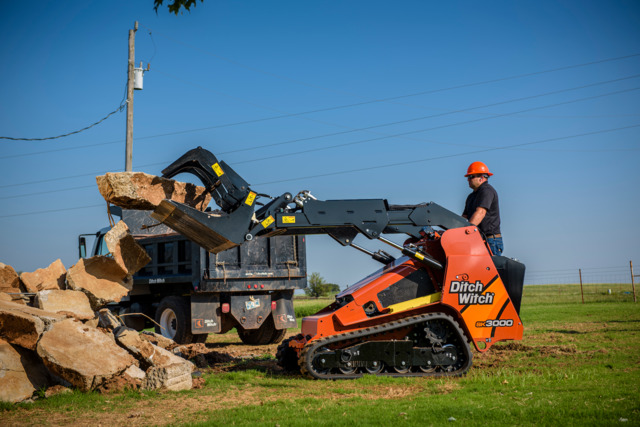 With 58.9 gross horsepower, the Ditch Witch SK3000 stand-on skid steer rivals the performance of traditional sit-in skid steer loaders but with a more compact machine. Width is 57.5 inches, length is 137.6 inches (with 66-inch bucket), and height is 44.6 inches. ROC is 3,102 pounds, and operating weight is 7,600 pounds with no attachments.Ditch Witch
With 58.9 gross horsepower, the Ditch Witch SK3000 stand-on skid steer rivals the performance of traditional sit-in skid steer loaders but with a more compact machine. Width is 57.5 inches, length is 137.6 inches (with 66-inch bucket), and height is 44.6 inches. ROC is 3,102 pounds, and operating weight is 7,600 pounds with no attachments.Ditch Witch
Picking the right CUL
Given the range of performance, attachments and applications available, how do you choose the right compact utility loader?
Kukuk says seasonal activities and ground conditions are important.
“Customers in Wisconsin will be looking for models that can do snow removal and operate on frozen ground, while customers in Georgia may be more focused on year-round landscaping tasks and green-industry-related projects.” Landscaping crews need greater maneuverability because they often work in customers’ backyards, while hardscaping crews need maximum power to handle heavy pallets of materials.
Newendorp, of Vermeer, notes that price is always a consideration, and buying the right CUL may not mean buying the biggest one.
“Consider the volume and type of material being moved or loaded, as well as the type and utilization rate of required attachments.” He says tree care, for example, is mostly grapples with some bucket work and maybe a need for forks. Compared to customers using trenchers and other high-demand attachments, tree care crews might require less hydraulic performance.
Picking the right CUL comes after other matters have also been resolved. Job descriptions dictate which attachments will be required, and in turn, attachment selection drives CUL selection to a large extent.
“Common attachments include augers for digging deep footings or posts, levelers to help with grading and site prep, various bucket attachments for various hauling needs on the jobsite and a grapple bucket for material handling,” says Toro’s Cartwright.
Hydraulic breakers and floor scraper attachments are also popular, especially for indoor construction and demolition. Also useful for indoor work and other environments where noise and exhaust are concerns is the Toro e-Dingo 500 wheeled electric CUL with its 515-pound rated operating capacity.
How long until delivery?
Sources agree that supply-chain issues, while improving, are far from over, and there is no spot on the horizon at which these issues will be fully resolved.
In the meantime, customers should work closely with dealers in the acquisition of compact utility loaders and attachments and to observe proper preventive maintenance and repair procedures to get maximum service life out of the machines already in their fleets.

